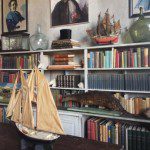Brandywine: Wyeth’s Other World
By • July 2, 2014 0 2007

Andrew Wyeth’s “Wind from the Sea” – the centerpiece of the “Looking Out, Looking In” exhibition at the National Gallery of Art (reviewed in the May 7 issue of The Georgetowner) – was painted a year before and on the same Maine farm as his iconic “Christina’s World” of 1948.
Cushing, Maine, where Christina Olson lived, was the painter’s summer home. Andrew Wyeth’s roots were in Chadds Ford, Pa., where the Brandywine River Museum of Art offers scheduled tours of his studio and the Kuerner Farm, both portrayed in several works in “Looking Out, Looking In.”
“His art is all about sense of place – things that mean something to him, people that mean something to him,” says Virginia O’Hara, the Brandywine museum’s curator of collections.
Upon their marriage in 1940, Andrew and Betsy Wyeth made a 19th-century schoolhouse their home and Andrew’s studio. Restored to look as it did when they lived there, the modest building – white, inside and out – is filled with old furniture, artists’ materials (brushes, a carton of eggs for making tempera paints, large blocks of watercolor paper), books on art, ship models and armies of toy soldiers. The kitchen has “modern” appliances from the 1950s.
Part of the studio is set up as the studio of their son James, known as Jamie, as if he were working on his 1967 portrait of John F. Kennedy. A short distance away is the expansive, prop-filled studio of Andrew Wyeth’s father and teacher, famed illustrator N.C. Wyeth, who built it in 1911 with earnings from his work on Scribner’s edition of “Treasure Island.” (The museum also has scheduled tours of N.C. Wyeth’s studio.)
Even more evocative is the bleakly beautiful farm of German immigrant Karl Kuerner, designated a National Historic Landmark in 2011 along with the Olson House in Cushing. A square, stone trough in front of two windows in the ancient barn is clearly the motif of the painting “Spring Fed” in “Looking Out, Looking In.” Another work in the National Gallery show depicts the farmhouse attic, with iron hooks from which onions and potatoes were hung.
No portraits of Wyeth’s Chadds Ford muse, Helga Testorf, who was Karl Kuerner’s nurse, are part of “Looking Out, Looking In,” but the painter had a way of instilling a human presence in his still lifes (not just art-history talk: in some cases a figure in an initial version of a work was later removed).
Much of the credit for preserving the scenic and historic landscape that Wyeth painted goes to the Brandywine Conservancy, founded in 1967 to protect the watershed. Having created the museum in 1971, the organization – based in a former gristmill off U.S. 1 – recently renamed itself the Brandywine Conservancy and Museum of Art.
A selection of Andrew Wyeth’s watercolors of Chadds Ford from the 1940s through the 2000s (he died in 2009) is on view at the museum through the end of September. “Exalted Nature: The Real and Fantastic World of Charles Burchfield,” an exhibition of more than 50 paintings by a very different American artist, opens Aug. 23.
The only name that looms larger than Wyeth in the Brandywine Valley is du Pont. DuPont, the chemical company, began in 1802 as Éleuthère Irénée du Pont de Nemours’s gunpowder mill on the Brandywine. His little family of Huguenot immigrants from Burgundy expanded in size and wealth in the 19th and 20th centuries to produce some of America’s greatest industrialists and philanthropists.
In 1906, Pierre S. du Pont bought the historic arboretum in Kennett Square, Pa., known as Peirce’s Park, making it his private estate and expanding it to more than 1,000 acres of gardens, fountains and greenhouses. We know it today as Longwood Gardens, welcoming roughly a million visitors annually. The latest addition to Longwood is an 86-acre Meadow Garden. Among the upcoming events are Summer Soirées on July 18 and Aug. 22 (free with admission) and Patti LuPone on July 10 ($45-75) and Savion Glover on Aug. 14 ($36-56).
Winterthur, the Wilmington mansion of one of Pierre’s cousins, Henry Francis du Pont, is furnished with his exceptional collection of American antiques and surrounded by gardens. It is a suitable setting for an audience-broadening Winterthur exhibition, “Costumes of Downton Abbey,” displaying 40 historically inspired costumes from the PBS series (through Jan. 4).
Other Wilmington cultural attractions include the Hagley Museum and Nemours Mansion, both connected to du Ponts, and the Delaware Art Museum, which features works by the Pre-Raphaelites, John Sloan and illustrators such as Howard Pyle.
Good dining choices may be found on State Street in downtown Kennett Square, where there is a monthly First Friday Art Stroll. For a country inn ambiance, try Buckley’s Tavern in Centerville, Pa., on Kennett Pike between Kennett Square and Wilmington.
To make an overnight or a weekend of it, there are 11 B&Bs listed on the Brandywine Valley Bed and Breakfast Association website. The landmark 1913 Hotel du Pont in Wilmington displays works by N.C., Andrew and Jamie Wyeth in its elegant public rooms.
- 2. Stone trough in the Kuerner barn, the subject of Andrew Wyeth’s “Spring Fed.”



